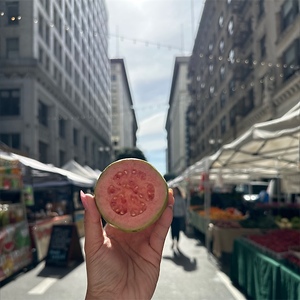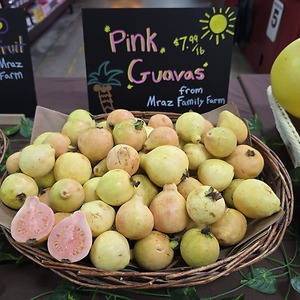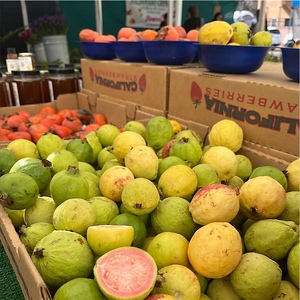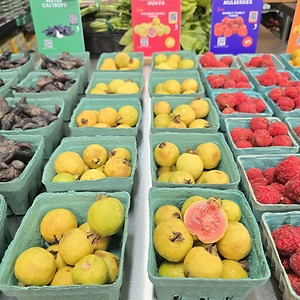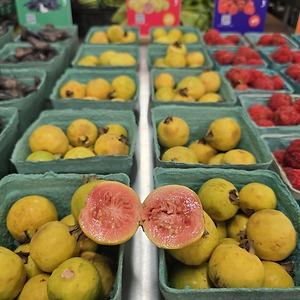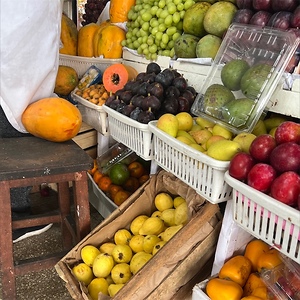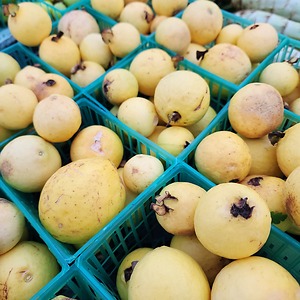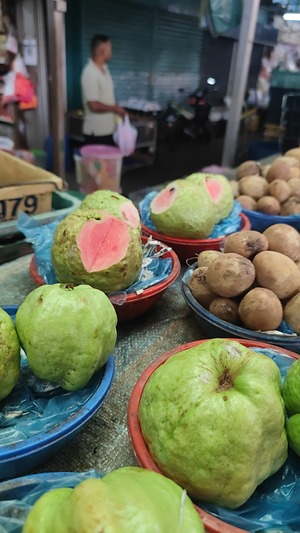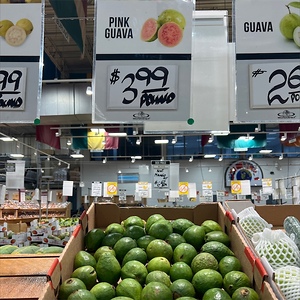

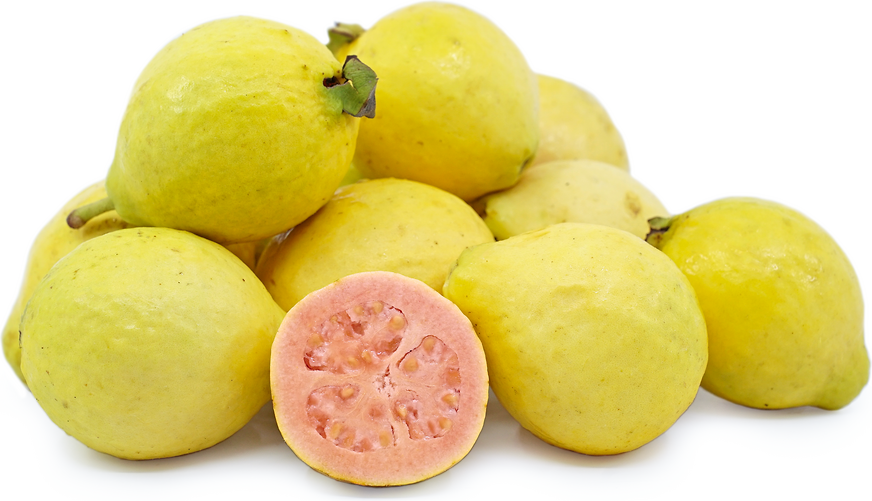
Pink Guavas
Estimated Inventory, lb : 0
This item was last sold on : 09/16/24
Description/Taste
Pink guavas are medium-sized fruits that typically measure between 6 and 10 centimeters in width. They have an ovate, lemon-like shape that tapers to a point at the top of the fruit. Pink guavas have bright green, lime-like skin that ripens to a bright yellow and has occasional brown markings. This skin may be bumpy and slightly misshapen or smooth and shiny depending on the individual fruit. They have salmon pink flesh that’s soft, succulent, creamy, and slightly granular, holding small round seeds that may be removed or eaten whole. Pink guavas have a sweet, musky fragrance with aromatic notes that are both fruity and slightly vegetal. They have a moderate acidity and a distinctly sweet and sour taste that contains tropical notes of papaya, passion fruit, melon, and ripe pear.
Seasons/Availability
Pink guavas are available in the late summer to early fall. In tropical climates, they may be available year-round.
Current Facts
Pink guavas are part of the Myrtle family, which also includes spices such as cinnamon, nutmeg, and cloves. The guava takes its name from guaiaba, meaning fruit in the Arawak language spoken by Indigenous peoples of the Bahamas where the fruit has been abundant for centuries. There are over 30 types of guavas, including varieties like Cherry, Strawberry, Miami red, and Apple guavas. These fruits are broadly classified according to the color of their flesh, being either white or a pink-red hue. Pink guavas are the most aromatic and can range from pale pink to deep orange-magenta. Their color is due to a naturally occurring organic pigment called carotenoid, the same compound that gives carrots and tomatoes their distinct warm hues. Pink guavas grow on trees that can reach 4.5 to 6 meters in height and are often planted for their ornamental white flowers as well as their fruit.
Nutritional Value
Pink guavas are high in vitamins A and C, nutrients that boost the immune system, produce collagen, encourage eye and skin health, and protect cells from damage. These fruits are also a great source of potassium, maintaining healthy blood pressure and proper muscle function. Their copper and manganese content is important for energy production, antioxidant defense, and metabolic function. The folate in Pink guavas supports DNA synthesis and repair, making them particularly beneficial for pregnant women as this aids in fetal development. These fruits are rich in dietary fiber, which improves digestive health by preventing constipation and promoting a healthy gut microbiome. Pink guavas have traditionally been used to treat diarrhea, allergies, and various dental and heart conditions.
Applications
Pink guavas can be used in both sweet and savory applications and may be cooked, preserved, dried, or eaten fresh. When fresh, they are often tossed into salads, fruit bowls, salsas, smoothies, granola, oatmeal, and yogurt. They have a high moisture content that easily cooks down into a paste or purée to be used for jams and fruit sauces. Puréed Pink guava may be served as a dipping sauce for fried cheese fritters or combined with soy sauce, lemon juice, and allspice for a sweet sauce to pour over chicken and pork. These fruits can be incorporated into baked goods like cakes, pies, tarts, pastries, empanadas, and cheesecake. Pink guavas may also be incorporated into ice creams, jams, jellies, juices, spritzers, and cocktails. These fruits are complemented by the flavors of bananas, ginger, honey, coconut, oranges, basil, mint, vanilla, strawberries, mango, pineapple, chili peppers, goat cheese, blackberries, and ham. Once ripe, Pink guavas should be stored in the refrigerator for 3 to 4 days.
Ethnic/Cultural Info
One of the most popular guava desserts is casquitos de guayaba. The word casquitos, meaning little helmets in Spanish, refers to how the halved guavas resemble small helmets when served in this dish. This traditional Cuban recipe involves peeling, halving, and seeding guavas, then simmering them in water and sugar over low heat. Once fully cooked, the guavas are left to soften and cool, and are typically served with cream cheese. Guava and cream cheese are also a common combination in Cuban culture. Cream cheese became popular in Cuba when American imperialism introduced it to the island, where it quickly gained favor with the locals. When Cubans started emigrating to Florida, they brought this cheese with them and bakers started incorporating the two flavors into pastries, which they called pastelitos de guayaba y queso.
Geography/History
Pink guavas are believed to have originated in Peru around 800 BCE and are now native to the American tropics of Northern South America, Central America, Mexico, and the Caribbean. They flourish in humid tropical and sub-tropical climates with well-drained soils. Pink guavas may grow wild in forests, fields, and along roadsides in their native areas. These fruits are also commercially cultivated and sown in home orchards. Pink guavas spread from their native Peru to the rest of South America, Central America, and Mexico by 200 BCE. They were then introduced to the Caribbean islands where Portuguese and Spanish colonists first discovered them in Haiti and brought them back to trade throughout India, Southeast Asia, and the Pacific Islands. Pink guavas are often found in larger supermarkets in their native regions and the tropical areas of Brazil, Columbia, South Africa, India, Hawaii, and Florida. In other areas, they can be found at specialty stores and farmers’ markets when in season.
Recipe Ideas
Recipes that include Pink Guavas. One



